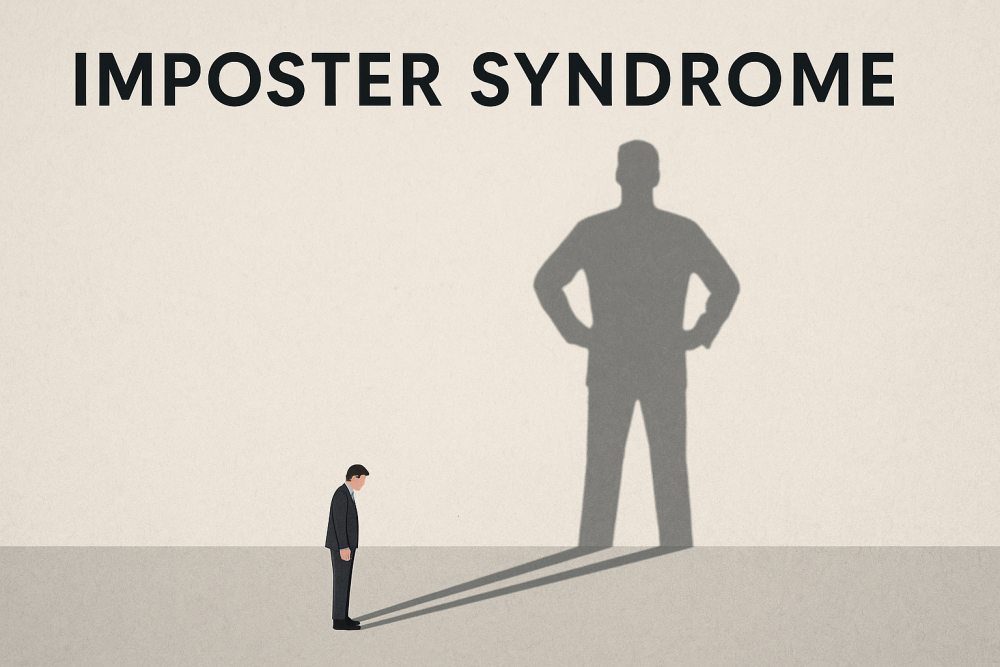We all have moments when we question our worth. You reach a milestone, deliver results, and yet a voice inside whispers, “You just got lucky.” This quiet self-doubt is often labelled impostor syndrome—a term that sounds official, even scientific. But once you give your brain a label, it builds a story around it. Before long, what began as a passing thought can become an identity.
What impostor syndrome really is
The phrase “impostor syndrome” was coined in the late 1970s to describe the experience of high-achieving people who secretly believe they do not deserve their success. Studies show that up to sixty percent of professionals feel this way at some point in their careers. It affects both men and women, though the reasons can differ. For women, social expectations often play a role. For men, pressure to appear confident and decisive can mask the same insecurity.
Yet despite decades of research, impostor syndrome is not a medical condition—it is a pattern of thinking. Once we call it a syndrome, we give it weight. The mind begins to treat it as fixed truth rather than a temporary feeling. And that story quietly shapes how we act, lead, and show up in the world.
The brain loves a label
Our brain is wired to look for patterns and meaning. When we name an experience—I’m anxious, I’m an impostor—the brain immediately searches for evidence to support that belief. This is not self-sabotage; it’s simply how the mind works. It wants to make sense of what we tell it. So if you keep affirming the label, it keeps proving it true.
This is why self-diagnosis can be tricky. It gives the illusion of control, but often traps us in a loop of confirmation. The more you identify with the label, the more your body, emotions, and behaviour start to act in alignment with it. Shoulders tighten, breathing shallows, and a low-grade tension takes over. What started as doubt becomes embodied.
Leadership starts with language
In my mentoring work, I see this pattern in people who appear accomplished on paper yet quietly question themselves. They think the label explains their behaviour, but what really holds them back is the story attached to it. The truth is, self-doubt is not a sign of failure; it is often the friction of growth. You are simply expanding faster than your mind can adjust.
Leadership—whether in business or in life—begins with the language you use. Every word you repeat becomes an instruction to the brain. When you say, “I have impostor syndrome,” your mind begins to act as if that is the reality you want. But when you say, “I’m learning to lead my life with clarity,” you shift your inner narrative. You move from being defined by the story to directing it.
A practical way forward
Through The Four Dimensions of Change: Body, Emotions, Mind and Accountability to Action, my Unbox BEMA™ Methodology, I teach clients to work with the body and mind together. Notice how your body reacts when you doubt yourself. Relax your shoulders. Breathe deeply. Curiosity softens judgement. Then give your mind a new, conscious command:
I am always growing, fulfilling my potential.
This simple act begins to rewrite the script that runs beneath the surface. Over time, the brain connects new dots—ones that affirm growth instead of fear.
From self-doubt to self-trust
You cannot lead others until you learn to lead your own mind. The way out of impostor thinking is not through more achievement, but through awareness. You start by observing your patterns, questioning the stories that no longer serve you, and giving your brain new instructions that match the life you’re ready to live.
If this article resonated with you, listen to the full conversation on Unbox The Podcast — Episode 45: “Impostor Syndrome: How to Own Your Success.”
🎧 Rewrite Your Story. Reclaim your power.
If you value my work, you can Buy Me A Coffee!
I’m Building a digital resources hub for growth.


